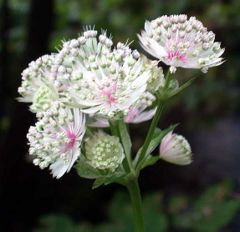Astrantia
| Astrantia subsp. var. | ||||||||||||||||||||||||||||||||||||||||||||||||||||||||
|---|---|---|---|---|---|---|---|---|---|---|---|---|---|---|---|---|---|---|---|---|---|---|---|---|---|---|---|---|---|---|---|---|---|---|---|---|---|---|---|---|---|---|---|---|---|---|---|---|---|---|---|---|---|---|---|---|

|
|
| ||||||||||||||||||||||||||||||||||||||||||||||||||||||
| ||||||||||||||||||||||||||||||||||||||||||||||||||||||||
| Standard Cyclopedia of Horticulture |
|---|
|
Astrantia (name in allusion to star-like appearance of umbels). Umbelliferae. Masterwort. Perennial garden plants, grown for the odd and ornamental umbels and attractive habit. Glabrous and erect low herbs with dark-colored aromatic roots: Lvs. palmately lobed or dissected, petioled, the st.-lvs. often sessile and more simple: fls. polygamous, the sterile long-pedicelled and the fertile short-pedicelled; calyx with 5 foliaceous lobes, more or less tuberculate; petals oblong-ovate, connivent: fr. compressed. — Perhaps a half-dozen species, in Eu. and W. Asia, bearing fls. in leafy-involucred umbels and umbellules, the fls. being white, rose-colored or blush. The astrantias grow a foot or more high, making interesting branching plants for the border, particularly in moist places. Prop, by seeds, and easily by divisions in autumn or spring. A. helleborifolia, Salisb. (A. heterophylla, Willd., A. maxima. Pall.). 2 ft. or less: radical lvs. 3-lobed, serrate: fls. pink: involucre of about 12 ovate-lanceolate bristly parts. Caucasus.—A. minor, Linn. 8-10 in.: radical lvs. 7-9-lobed, toothed: fls. white: involucre white. Eu. L. H. B.
|
Astrantia {{{latin_name}}}
|
'
| ||||||||||||||||||||||||||||||||||||||||
|---|---|---|---|---|---|---|---|---|---|---|---|---|---|---|---|---|---|---|---|---|---|---|---|---|---|---|---|---|---|---|---|---|---|---|---|---|---|---|---|---|---|

|
|
| |||||||||||||||||||||||||||||||||||||||
| |||||||||||||||||||||||||||||||||||||||||
- Do you have a description of this genus or plant? Edit this section!
Cultivation
| calendar? | ||
|---|---|---|
| January: | ||
| February: | ||
| March: | ||
| April: | ||
| May: | ||
| June: | ||
| July: | ||
| August: | ||
| September: | ||
| October: | ||
| November: | ||
| December: | ||
| Notes: | ||
- Do you have cultivation info on this plant? Edit this section!
Propagation
- Do you have propagation info on this plant? Edit this section!
Pests and diseases
- Do you have pest and disease info on this plant? Edit this section!
Species
Gallery
If you have a photo of this plant, please upload it! Plus, there may be other photos available for you to add.
-
photo 1
-
photo 2
-
photo 3
References
External links
- w:Astrantia. Some of the material on this page may be from Wikipedia, under the Creative Commons license.
- Astrantia QR Code (Size 50, 100, 200, 500)
